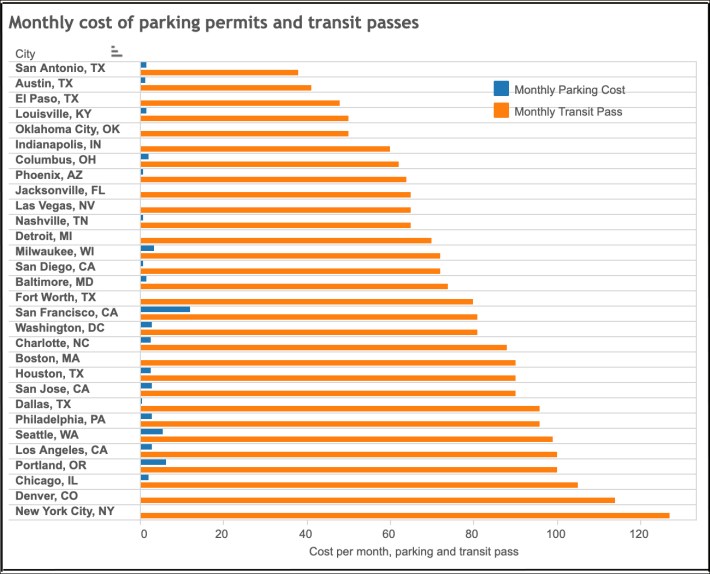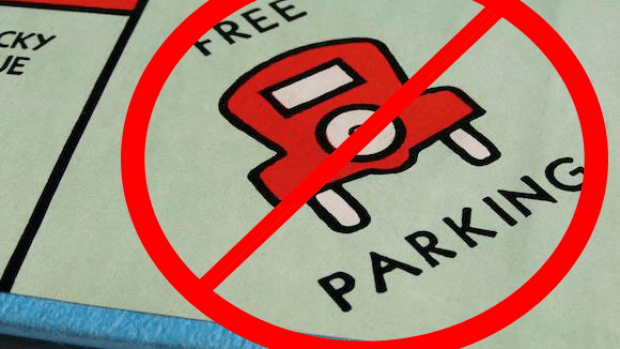
On an average day, the typical car owner doesn’t give much thought to parking, beyond whether they will luck out and find a spot to park when they reach their destination.
We’ve had this luxury — even if it feels like a pain — because for nearly a century, our cities have been oriented around the automobile. In many American cities, up to 98 percent of people own a car. We allocate space for parking, because otherwise how would we go about our lives? It makes sense.
Or does it?
It’s estimated that a one lane mile of roadway costs about $2 million tax dollars to build. Add to that maintenance, wages for parking enforcement staff and other costs, and free parking isn’t really free. Parking costs money, and the spot by the curb you squeeze into is paid for by all of us, through our tax dollars.
This subsidy to those who can afford to own a car is, of course, not only fronted by car owners, who are disproportionately middle-class and upper-class citizens. Lower income people who can’t even afford cars are also making that lucky parking spot you found possible, through the taxes they pay.
People who don’t own cars pay the price for our automobile-centered approach in other ways, too. It is estimated that 30 percent of all traffic, based on analysis of traffic patterns, is made up of drivers searching for parking spot — circling blocks, wasting fuel, and congesting roadways.
In the latest analysis done by the Department of Transportation in New York City, average bus speeds have slowed to their lowest in decades: only 7.58 miles per hour. Lower-income communities disproportionately rely on these public forms of transportation. Congestion from cars looking for parking slows down public transit, sucking up time from those who already work the longest hours for the least pay.
Clogged traffic also lowers the wages of the many gig workers who rely heavily on tips for their living. The longer it takes them to accomplish their delivery, the lower their hourly pay rate drops.
It may seem odd to suggest that a passive parking spot at the side of an already-paved road is actively costing us loads of cash. But it is, if you factor in lost revenue opportunities for cities.
Donald Shoup, a professor of urban planning at UCLA, suggests that instead of free or metered parking, cities should be charging market rates for the real estate a car occupies. This money, in turn, can be used for public services on that very block. It can also be used to increase services or bike lanes in surrounding, less affluent parts of the city. If we put the money generated by properly charging for parking space into making public transit more efficient and comprehensive, we’d have yet another reason to stop throwing good tax money (or your own money) at cars.

Some cities are looking at changing this urban equation by reconfiguring parking to prioritize better commercial, as opposed to individual, access to the curb. Hard data shows that when parking priorities are shifted based on actual traffic patterns and curb needs, commercial vehicles such as UPS and FedEx, food-delivery, and ride-hailing services are able to operate more efficiently and safely. Double parking and traffic congestion is reduced by as much as 20 percent.
Delivery companies have shown themselves willing to pay cities for this privilege - creating new revenue streams for cities to reinvest in urban projects - because ultimately it saves them traffic fines and improves their efficiency. In Columbus, Ohio, delivery drivers accessing an area with specified stopping areas prevented approximately 9,700 double or illegal parkings. The time-savings generated by an allocated place to stop and the elimination of driver parking tickets translates to big cost-savings for the Amazons and FedExes of the world, which in an ideal world gets passed along to the end consumer.
At this point in the piece, car owners might be fuming (so to speak). With the average American spending 16 cents of every dollar they earn on transportation, many of us can’t afford to pay market rates for parking. In many places, taking a bus or subway isn’t even an option. Forty-five percent of Americans have no access to public transit, making car ownership a necessity in many areas.
Yes, we can’t deny that free parking makes it cheaper to own a car. But, as Shoup points out, it also makes everything else more expensive. Your rent has the cost of the building parking lot built into it. Your grocery prices have the price of traffic congestion and wasted fuel as part of the calculus. Subsidies for parking and roadways take money away that could be spent on improving access and efficiency of public transit, which in the end could alleviate the necessity to own a car. Road subsidies also push up tax rates, take money away from other government services, and create a vicious circle that just perpetuates the need to drive.
There’s another reason we can’t afford to keep prioritizing our cars. Parking is a major contributor to traffic and in turn, greenhouse gases. In one pilot, traffic caused by drivers searching for parking dropped by more than 20 percent. With transportation accounting for 29 percent of United States greenhouse gas emissions in 2017, better street management could contribute to significant reduction in emissions. This is also an equity issue. A study of about 13.2 million Medicare recipients revealed that low socioeconomic status consistently increased the risk of premature death from fine particle pollution. Demographic data from the 2000 census showed that minorities are on average exposed to 38 percent higher levels of air pollution than whites in the communities where they live, with most of that pollution related to vehicle traffic.
It is difficult to change our habits. Cars are convenient. But once you factor in the time costs, the safety issues associated with the automobile, noise pollution and emissions, subsidizing cars makes less and less sense. At the end of the day, our current parking model means poorer citizens are subsidizing our wealthier ones when it comes to transportation. We must shift the orientation of our cities.
By thinking intelligently about how we can better allocate our curbside space we can cut emissions, create more revenue for cities to reinvest in transportation, make traffic flow better and make our cities more equitable. The lowly curb is often overlooked, but it can play an outsized role in making our cities better places to live.
Jordan Justus is the CEO and co-founder of Automotus. The views expressed in guest contributions do not necessarily reflect the views of Streetsblog staff.






